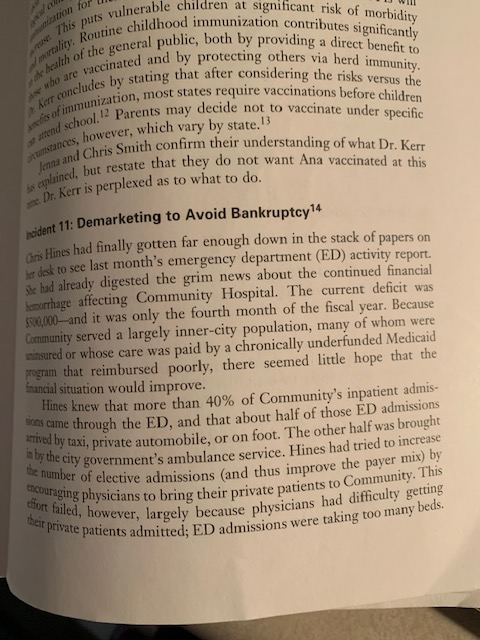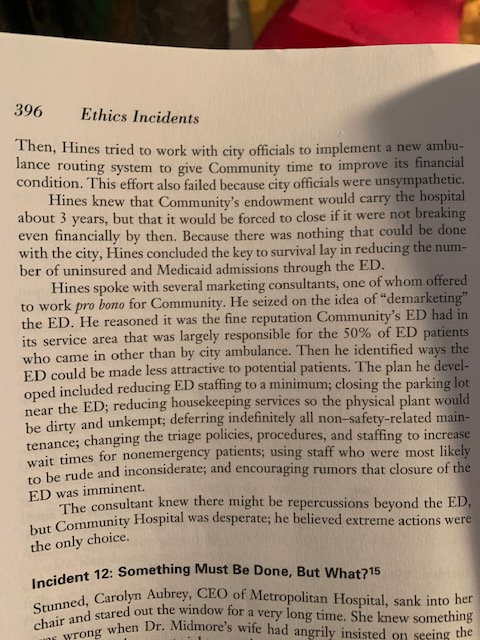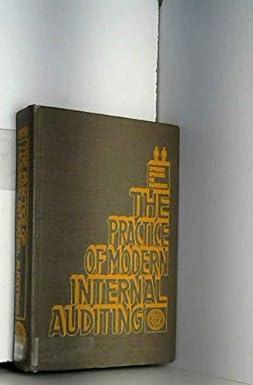

Incident #11 Demarketing to Avoid Bankruptcy
-
Discuss medical ethical principles that apply to this case.
-
Identify possible strategies that use political processes in the community and the city that assist Community Hospital to remain financially viable.
-
What ethical theories support demarketing as a strategy?
-
What results are likely if demarketing is successful?
ition for 12 Dr. Kerr is perplexed as to what to do. This puts vulnerable children at significant risk of morbidity waliny. Routine childhood immunization contributes significantly health of the general public, both by providing a direct benefit to vaccinated and by protecting others via herd immunity. kerr concludes by stating that after considering the risks versus the of immunization, most states require vaccinations before children tend school. Parents may decide not to vaccinate under specific tumstances, however, which vary by state. 13 Jenna and Chris Smith confirm their understanding of what Dr. Kerr is anlained, but restate that they do not want Ana vaccinated at this noident 11: Demarketing to Avoid Bankruptcy14 unived by taxi, private automobile, or on foot. The other half was brought in by the city government's ambulance service. Hines had tried to increase the number of elective admissions (and thus improve the payer mix) by tncouraging physicians to bring their private patients to Community. This effort failed, however, largely because physicians had difficulty getting their private patients admitted; ED admissions were taking too many beds. Gris Hines had finally gotten far enough down in the stack of papers on fer desk to see last month's emergency department (ED) activity report. site had already digested the grim news about the continued financial hemorrhage affecting Community Hospital. The current deficit was $300,000and it was only the fourth month of the fiscal year. Because Community served a largely inner-city population, many of whom were minsured or whose care was paid by a chronically underfunded Medicaid program that reimbursed poorly, there seemed little hope that the financial situation would improve. Hines knew that more than 40% of Community's inpatient admis- unes came through the ED, and that about half of those ED admissions Incident 12: Something Must Be Done, But What? 15 chair and stared out the window for a very long time. She knew something Stunned, Carolyn Aubrey, CEO of Metropolitan Hospital, sank into her me wrong when Dr. Midmore's wife had angrily insisted on seeing the 396 Ethics Incidents Then, Hines tried to work with city officials to implement a new ambu- lance routing system to give Community time to improve its financial condition. This effort also failed because city officials were unsympathetic. Hines knew that Community's endowment would carry the hospital about 3 years, but that it would be forced to close if it were not breaking even financially by then. Because there was nothing that could be done with the city, Hines concluded the key to survival lay in reducing the num- ber of uninsured and Medicaid admissions through the ED. Hines spoke with several marketing consultants, one of whom offered to work pro bono for Community. He seized on the idea of "demarketing" the ED. He reasoned it was the fine reputation Community's ED had in its service area that was largely responsible for the 50% of ED patients who came in other than by city ambulance. Then he identified ways the ED could be made less attractive to potential patients. The plan he devel- oped included reducing ED staffing to a minimum, closing the parking lot near the ED; reducing housekeeping services so the physical plant would be dirty and unkempt; deferring indefinitely all non-safety-related main- tenance; changing the triage policies, procedures, and staffing to increase wait times for nonemergency patients; using staff who were most likely to be rude and inconsiderate; and encouraging rumors that closure of the The consultant knew there might be repercussions beyond the ED, but Community Hospital was desperate; he believed extreme actions were ED was imminent. the only choice. ition for 12 Dr. Kerr is perplexed as to what to do. This puts vulnerable children at significant risk of morbidity waliny. Routine childhood immunization contributes significantly health of the general public, both by providing a direct benefit to vaccinated and by protecting others via herd immunity. kerr concludes by stating that after considering the risks versus the of immunization, most states require vaccinations before children tend school. Parents may decide not to vaccinate under specific tumstances, however, which vary by state. 13 Jenna and Chris Smith confirm their understanding of what Dr. Kerr is anlained, but restate that they do not want Ana vaccinated at this noident 11: Demarketing to Avoid Bankruptcy14 unived by taxi, private automobile, or on foot. The other half was brought in by the city government's ambulance service. Hines had tried to increase the number of elective admissions (and thus improve the payer mix) by tncouraging physicians to bring their private patients to Community. This effort failed, however, largely because physicians had difficulty getting their private patients admitted; ED admissions were taking too many beds. Gris Hines had finally gotten far enough down in the stack of papers on fer desk to see last month's emergency department (ED) activity report. site had already digested the grim news about the continued financial hemorrhage affecting Community Hospital. The current deficit was $300,000and it was only the fourth month of the fiscal year. Because Community served a largely inner-city population, many of whom were minsured or whose care was paid by a chronically underfunded Medicaid program that reimbursed poorly, there seemed little hope that the financial situation would improve. Hines knew that more than 40% of Community's inpatient admis- unes came through the ED, and that about half of those ED admissions Incident 12: Something Must Be Done, But What? 15 chair and stared out the window for a very long time. She knew something Stunned, Carolyn Aubrey, CEO of Metropolitan Hospital, sank into her me wrong when Dr. Midmore's wife had angrily insisted on seeing the 396 Ethics Incidents Then, Hines tried to work with city officials to implement a new ambu- lance routing system to give Community time to improve its financial condition. This effort also failed because city officials were unsympathetic. Hines knew that Community's endowment would carry the hospital about 3 years, but that it would be forced to close if it were not breaking even financially by then. Because there was nothing that could be done with the city, Hines concluded the key to survival lay in reducing the num- ber of uninsured and Medicaid admissions through the ED. Hines spoke with several marketing consultants, one of whom offered to work pro bono for Community. He seized on the idea of "demarketing" the ED. He reasoned it was the fine reputation Community's ED had in its service area that was largely responsible for the 50% of ED patients who came in other than by city ambulance. Then he identified ways the ED could be made less attractive to potential patients. The plan he devel- oped included reducing ED staffing to a minimum, closing the parking lot near the ED; reducing housekeeping services so the physical plant would be dirty and unkempt; deferring indefinitely all non-safety-related main- tenance; changing the triage policies, procedures, and staffing to increase wait times for nonemergency patients; using staff who were most likely to be rude and inconsiderate; and encouraging rumors that closure of the The consultant knew there might be repercussions beyond the ED, but Community Hospital was desperate; he believed extreme actions were ED was imminent. the only choice








